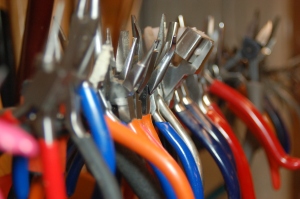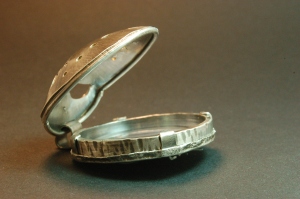 What good is a book?
What good is a book?
After all, we can find just about anything on the internet these days, right?
Call me a romantic, but I’m the one who argued in a graduate-level journalism class that the internet would never completely replace newspapers because there is something about the crinkle of the paper and getting the ink on your hands. That was in 1991 or 1992, when the internet was just a notion. (I should have known then that I would be drawn to tactile art processes.)
Even today, I still believe this is true, particularly for community newspapers providing hyperlocal coverage.
And I feel the same way about books.
Ink that forms words …
Words that form language …
Language that forms ideas …
… Presented on paper pages, bound together between covers. While you are reading, you can hold it, smell it, mark it, flip it, stack it, throw it.

Ink to Ideas
A collection of books on a particular topic is a sweet asset, a resource worth building. My studio library continues to grow. I own many of the standard titles in the field, plus I regularly add titles based on trends in the field, artists’ whose work I admire, or just aspects that interest me.  In addition to the fact that building a professional library is tax-deductible, I need to have the information in a book that I can just reach up and grab whenever I need it. My memory is intensely visual. So, after I’ve read something, I will recall the cover aesthetic, and whether it’s on a left- or right-facing page, high or low, etc. So, when I’m in the middle of building a hinge knuckle, if I need to look up what Tim McCreight wrote about it, I need to be able to get to my copy of The Metalsmith’s Book of Boxes and Lockets. Now.
In addition to the fact that building a professional library is tax-deductible, I need to have the information in a book that I can just reach up and grab whenever I need it. My memory is intensely visual. So, after I’ve read something, I will recall the cover aesthetic, and whether it’s on a left- or right-facing page, high or low, etc. So, when I’m in the middle of building a hinge knuckle, if I need to look up what Tim McCreight wrote about it, I need to be able to get to my copy of The Metalsmith’s Book of Boxes and Lockets. Now.
 Despite the overwhelming wealth of information available on the internet, I still believe there is incredible value in owning certain books. If I own the book, that means the writer was paid. That’s the way it should be, and that’s certainly not always true online. Granted, a printed book is not as environmentally friendly as a downloaded e-book. But if I own the bound book, I have the experience of physically interacting with it, which means I will learn more.
Despite the overwhelming wealth of information available on the internet, I still believe there is incredible value in owning certain books. If I own the book, that means the writer was paid. That’s the way it should be, and that’s certainly not always true online. Granted, a printed book is not as environmentally friendly as a downloaded e-book. But if I own the bound book, I have the experience of physically interacting with it, which means I will learn more.
Truly learn more.
Let me tell you why I think so.
 In 1980, I believed my mother was The Smartest Person on the planet.
In 1980, I believed my mother was The Smartest Person on the planet.
In 1977, I decided my father was a Mechanical Genius, a master problem-solver capable of fixing absolutely any broken thing.
Granted, I was a youngster, and like most children, my parents were the center of my world. My mother is, indeed, extremely intelligent. And my father is, indeed, able to fix things, all kinds of things mechanical and otherwise. My childhood instincts were right.
So, because my mother was so knowledgeable, I was hoping to use her knowledge as an asset to make my life a little easier.
This is me, in 1980:
“Mama, what does U-B-I-Q-U-I-T-O-U-S mean?”
“Go look it up,” she’d reply.
“Just tell me.”
“No. Go look it up.”
So, I did.
A month later:
“Mama, what does ‘gerrymandering’ mean?”
“Go look it up.”
“OK.”
I knew my mother held in her bank of knowledge the answers to my questions. I knew she knew what these words meant, and I thought she should just tell me so I wouldn’t have to interrupt my reading, get up out of my chair, go pull down the dictionary, flip to the U’s, find “ubiquitous”….
 If she would just tell me, then I would have to expend less energy to understand what I needed to know in that moment. Me lazy? Perhaps. Or, just looking to cut a corner. (Is there a difference?)
If she would just tell me, then I would have to expend less energy to understand what I needed to know in that moment. Me lazy? Perhaps. Or, just looking to cut a corner. (Is there a difference?)
 But, my mother knew that if I went through the act of doing my own research, I would be much more inclined to recall the information later. To this day, I can define ubiquitous for you. I’ve known this since 1980.
But, my mother knew that if I went through the act of doing my own research, I would be much more inclined to recall the information later. To this day, I can define ubiquitous for you. I’ve known this since 1980.
 I learned to value knowledge and to actively seek it. The more I learn, the more aware I become of the vast unknown. And just as a love affair is about more than a decision to partner with someone, reading, whether just for fun or seeking information, is about more than answering a question.
I learned to value knowledge and to actively seek it. The more I learn, the more aware I become of the vast unknown. And just as a love affair is about more than a decision to partner with someone, reading, whether just for fun or seeking information, is about more than answering a question.
The internet has made it almost too easy for us to answer all of our questions, immediately. I am just as guilty as anyone else of pulling out my Smartphone during dinner to find the answer to some question that has come up in dinner conversation. And as I announce, definitively, the differences between Mexican and Southwestern cuisine, for example, I am haughty and proud because I am the one with The Internet in my pocket. Nevermind that I am also the one who isn’t completely present at the table and who has robbed everyone else of the whimsical joy of wondering about something for a while.
 My love of books has worked its way into my work in recent years, primarily in my Reading The Key series of metal sculpture, jewelry, essays and paintings. It was truly a series that came not from me as an artist, but through me. All of the paintings are mixed media, including actual book pages. The metal pieces have book text etched onto the metal surfaces. The concept of the series itself is about the power of the written word, its impact on the writer, on the reader and on our collective consciousness.
My love of books has worked its way into my work in recent years, primarily in my Reading The Key series of metal sculpture, jewelry, essays and paintings. It was truly a series that came not from me as an artist, but through me. All of the paintings are mixed media, including actual book pages. The metal pieces have book text etched onto the metal surfaces. The concept of the series itself is about the power of the written word, its impact on the writer, on the reader and on our collective consciousness.
Don’t get me wrong. I use the internet daily, and I value it as an amazing tool. Of course, I recognize that blogs (like mine) would not even exist without the internet. But, I monitor my own attachment to it, as it can be somewhat of a passive way to learn, just as it would have been for my mother to just tell me the meanings of those words I didn’t know.
Just as public libraries grew in the 19th century in America and offered the people more resources than they had before, the internet has become and will continue to be an immense resource. But, I am not getting rid of my books.
.

Thanks for reading.
Posted in art, books, creativity, Studio Happenings
Tags: art, bookbinding, books, creativity, literacy, metalsmith, reading, story, writing
 This space, this room, will be my gallery.
This space, this room, will be my gallery.


























































Recent Comments